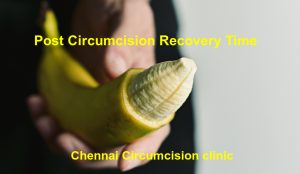Circumcision is usually a simple operation, with relatively low risk of complications. However, it is not always as simple a decision to make. “How long can I delay circumcision ?” is the most common question an adult male puts forth, relative to an advise or a need for a medical circumcision. Though the fact that medically indicated circumcision has to be done at the earliest is well established, it is never an easy decision for the man to put his manhood through the knife. Even if a man is willing to be circumcised this does not mean he will end up having the procedure done at the required time. This is because a large number of obstacles have been documented, such as fear of pain or complications, embarrassment, inconvenience and cost. It is reasonable to suppose that, if these barriers could be addressed through the provision of correct information and assistance, the fraction of men willing to be medically circumcised at the appropriate time would increase significantly. Here is an explanation that addresses some common factors to help men overcome the fear of circumcision and be decisive in their interest.

- The effects of pain and trauma – most adult circumcisions tend to be for treatment of a medical condition that causes pain, inflammation and irritation that is far more than minimal pain experienced after circumcision. Although pain is overall minor and should not be seen as a major barrier, the fear of pain for later circumcision does represent a significant barrier. In practice, the pain associated with medical circumcision is far less than men anticipate and many are not aware that local anaesthesia is recommended. More so, latest techniques of stapler circumcision are almost pain free and offer the advantage of quick healing and minimal tissue damage.
- Grieving the loss of a body part – circumcision timing has the same implications for all infections that can be prevented by the procedure. A sexually active male is exposed to a period of increased risk of several infections. The length of this period varies according to the time at which circumcision is eventually performed. In countries with a high prevalence of Sexually Transmitted Infections (STIs), the risk of infection before a male undergoes adult circumcision may be considerable. HPV is an epidemic in virtually all countries worldwide. The issue of infection with an STI during the post circumcision healing period does not arise. Grieving the acquisition of an infection is far worse than grieving the loss of the foreskin.

HPV
- Recovery time – although the amount of time required for recovery from an advanced circumcision procedure is typically small, the time off can affect productive work. In one study of men circumcised with the use of a latest device, men took an average of 1.1 days off work; 80% were back at work by day 2, with only 20% requiring more than 2 days, and little disruption to activities. Eighteen percent of men in the study reported disruption to their work during recovery period and 30% had not resumed routine leisure activities by 7 days. Only 4% of men required 3 days or more before they could return to normal activities. Uncircumcised conditions of Phimosis and Balanitis requiring repeated medical attention can comparatively sap more time away from productive work. The more the circumcision is delayed, the more recurrent are the penile infections and longer the episodes of illness.

- Impact on sexual life – fears and anxieties about sexual pleasure appear to be substantial. This may be especially problematic in developed countries with widespread Internet access, as this medium is dominated by anti-circumcision movements which may claim that circumcision severely harms the sexual experience. It is only a belief that circumcision might reduce their sexual pleasure. In a large Danish study in which circumcision, mostly for medical reasons, accounted for the small proportion of circumcised men surveyed, there were no differences in a range of sexual measures, as was also the case for 14% of men in an Indian study. Scientific evidence regarding the sexual effects of Circumcision does not substantiate the purported harms to sexual pleasure. Quality studies have found no adverse effect of circumcision on penile sensitivity, sensation during arousal, sexual satisfaction, premature ejaculation, intravaginal ejaculatory latency time or erectile function. In fact, some reports reveal that sexual experience of most men was enhanced after circumcision and also reduced the risk of premature ejaculation.

- Cultural affiliation – in India, circumcision is a mark of religious affiliation, 41% of a majority religion men are concerned that circumcision is not a part of their culture, while 30% were afraid of stigma or rejection. Circumcision has historic implications in India, where certain group of men were targeted for violence based on their circumcision status during days of fundamentalist massacres and subsequent riots. It has been observed that circumcision in India might be more acceptable in STI clinic attendees than others and this needs to see the change. It’s time that men accept medical reasoning for circumcision just like advancements in lifestyle, eating habits and other cultural aspects of healthy living.
- Cost effectiveness – in a cost-benefit analysis, it is found that for a range of medical conditions, “much of the cost of circumcision is eventually recovered when disease and the medical need for otherwise conditions are prevented”. Similarly, circumcision is calculated to provide enormous cost savings in populations where HIV prevalence is high. Cost-effectiveness studies found adult circumcision to be very cost-effective, the cost per HIV infection averted.
Circumcision provides a “window of opportunity” for men to avoid many penile conditions and ailments. It is associated with substantially lower costs, lower risk of complications when performed by an experienced operator in a clinical or other appropriate setting and lower lifetime risk of a variety of adverse conditions and infections. The health benefits include protection against urinary tract infection and thus permanent damage to the kidney, reduced likelihood of penile inflammation and permanent correction of phimosis, which impedes micturition and results in difficult and painful erections in adult men. It also means tearing of the fragile foreskin and frenulum is avoided. Circumcision means an assurance of greatly reduced risk of penile cancer later in life, no smegma, better hygiene, lesser chances of balanitis and lower risk of various STIs. These not only include HIV that is an epidemic in some locations, but also oncogenic HPVs and genital herpes that are an epidemic worldwide. In addition, female sexual partners of circumcised men have been shown to have reduced risk of cervical cancer and chlamydial infection. Adult circumcision has benefits most certainly, but a man must be willing to avail himself of these by getting circumcised. It is therefore important to examine the timely acceptability of circumcision by adult males. Thus, in contrary to raising the question “How long can I delay circumcision ?” , rethink and question “How early can I get circumcised ?”.


